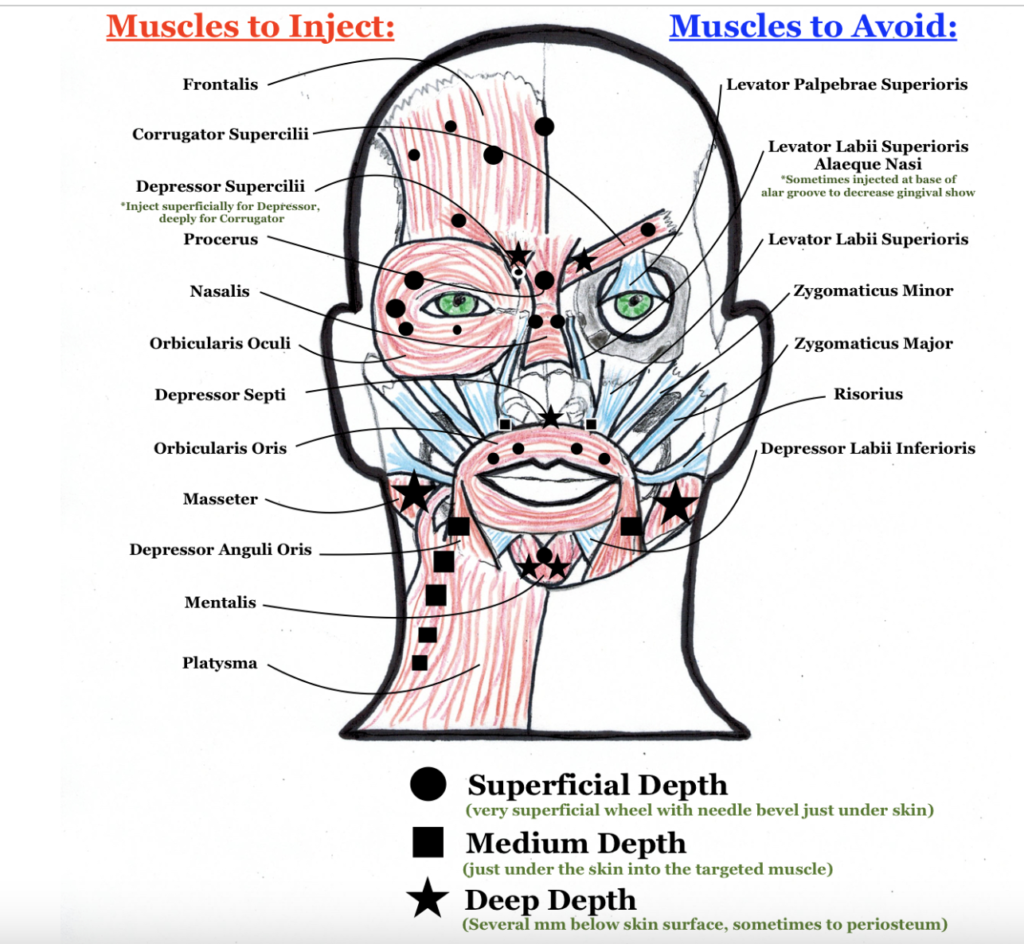
Guidelines for injecting neurotoxins and fillers involve a deep understanding of facial anatomy to ensure effective and safe outcomes. Here are key points on which muscles to inject and which to avoid:
Neurotoxin Injections
Muscles to Inject:
- Upper Face:
- Frontalis: To reduce horizontal forehead lines.
- Corrugator Supercilii and Procerus: To treat glabellar lines (frown lines) between the eyebrows.
- Orbicularis Oculi: For crow’s feet around the eyes[1][5].
- Lower Face:
- Masseter: For jaw slimming and treating bruxism.
- Mentalis: To address chin dimpling or a “cobblestone” appearance[2].
Muscles to Avoid:
- Avoid injecting neurotoxins into areas that could lead to unwanted muscle relaxation, such as the muscles responsible for smiling or lip movement, unless specifically targeting issues like gummy smiles or downturned lips. Precision is crucial to avoid complications like asymmetry or impaired facial expressions[5].
Filler Injections
Areas to Inject:
- Midface:
- Cheeks: To restore volume and contour.
- Nasolabial Folds: To soften deep lines[4].
- Lower Face:
- Lips: For augmentation and contouring.
- Marionette Lines: To reduce the appearance of lines running from the corners of the mouth to the chin[3].
Areas to Avoid:
- Avoid injecting fillers into areas with high vascularity or near critical structures to prevent complications like vascular occlusion. For example, the glabella region is risky due to its vascular supply[3].
General Considerations
- Anatomy Knowledge: A thorough understanding of facial anatomy, including the depth and location of muscles and blood vessels, is crucial for both neurotoxin and filler injections[3].
- Technique: Use appropriate techniques, such as aspirating before injecting fillers to reduce the risk of intravascular injection, and using small amounts of neurotoxin to avoid over-relaxation of muscles[3][6].
- Patient-Specific Factors: Consider individual anatomical variations and patient-specific goals to tailor the treatment plan[3].
Overall, successful outcomes with neurotoxin and filler injections depend on the injector’s expertise, precise technique, and detailed anatomical knowledge.
Citations:
[1] https://www.ncbi.nlm.nih.gov/books/NBK574523/
[2] https://www.ncbi.nlm.nih.gov/pmc/articles/PMC10520866/
[3] https://www.ncbi.nlm.nih.gov/pmc/articles/PMC7497045/
[4] https://emedicine.medscape.com/article/1574158-overview
[5] https://www.theblondeinjector.com/blog/where-to-avoid-getting-botox
[6] https://tracydentalspa.com/understanding-neurotoxin-treatment-frequency-and-aftercare/
[7] https://www.mayoclinic.org/tests-procedures/botox/about/pac-20384658
